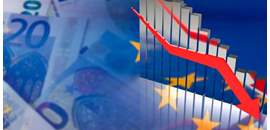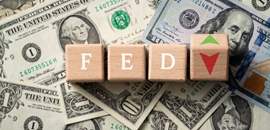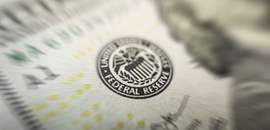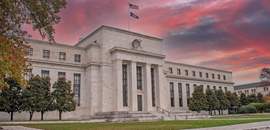The Federal Reserve's Influence on Markets
The first chart below shows a close correlation between 10-year Treasury yields and the trade-weighted dollar index over this period. Bonds have sold off (yields have increased), and the dollar has rallied when investors believed the Fed would raise rates. Conversely, yields have fallen, and the dollar has weakened when investors anticipated an end to Fed tightening.
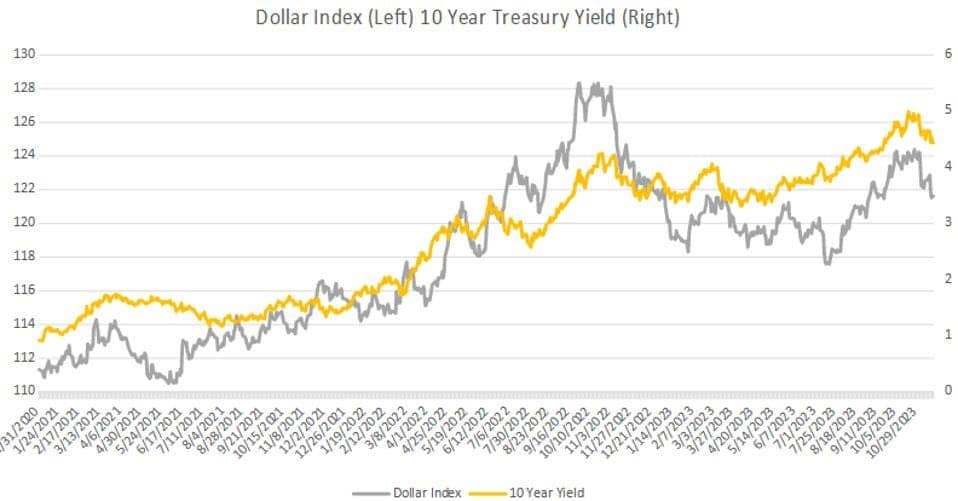 Dollar Index Treasury Yield | FRED
Dollar Index Treasury Yield | FRED
The second chart below shows that the stock and bond markets also moved in tandem for most of this period. (Note: The right-hand axis for bond yields is inverted to facilitate the comparison). Prior to June of this year, both markets sold off when the Fed was expected to raise interest rates, and they rallied when investors believed the Fed had finished tightening.
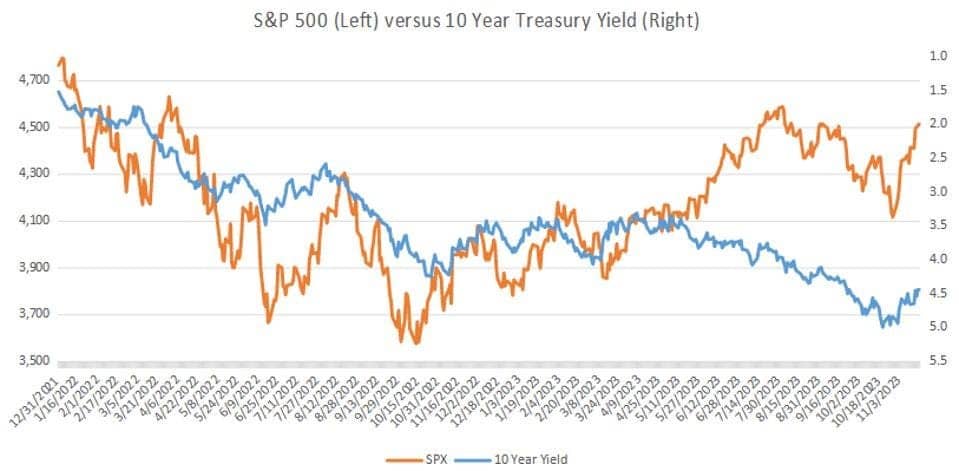 S&P500 vs 10 Year Treasury | FRED
S&P500 vs 10 Year Treasury | FRED
Divergence in Q3: Bond Yields Spike & Stock Market Advances
However, both markets diverged in the third quarter when real GDP growth turned out much stronger than expected, causing bond investors to throw in the towel that the Fed would lower rates, and 10-year Treasury yields spiked to a 15-year high of 5%. The stock market advanced, nonetheless, as equity investors took comfort that the risk of recession had lessened.
More recently, both the bond market and stock market have rallied significantly amid favorable inflation readings and signs that the labor market is moderating. The bond market is now pricing in that the Fed will lower the funds rate by 75-100 basis points next year beginning in the spring, and stock investors appear to concur with this assessment.
The main problem with jumping aboard the bandwagon, however, is that investors have been wrong in anticipating Fed policy over the past two years.
According to a research report by Deutsche Bank cited in Markets Insider (November 17), the U.S. stock market has incorrectly priced in a Fed pivot six times over that period. Deutsche Banks’ economists caution that while Fed rate cuts are possible next year, the final stretch in bringing inflation down to the Fed’s 2% target rate tends to be the most difficult. Indeed, Fed officials have indicated they are not ready to declare the inflation fight is over, and they caution that there could be a further tightening if the economic data warrant it.
Key Considerations for Investors Amidst Uncertain Fed Polices
My take is two main considerations will influence the Fed’s decision on rates.
1. Core Inflation
Firstly, Fed officials want to be sure that core inflation, which excludes the volatile food and energy components, is well on its way to approaching its 2% average annual target. This is a necessary condition for the Fed to leave rates on hold.
It does not mean that the core rate must reach 2% precisely, but Fed officials would probably need to see the rate fall below 3% to be convinced they are within striking distance of their goal. The Fed’s latest projections as of September suggest this outcome is possible, with the median forecast for core PCE inflation at 2.6% in 2024 and 2.3% in 2025. Although Fed policymakers are reluctant to declare the fight to lower inflation is over, they could shift to a neutral stance before long.
2. Weakening Economy
The second consideration is that in order for the Fed to ease monetary policy, it must be convinced that the economy is weakening. The key indicator it will use to render this assessment is whether there is evidence of slack in the labor market.
What is striking about the Fed’s assessment, in this regard, is the latest projections do not indicate Fed officials are particularly worried about rising unemployment or a recession. Indeed, the unemployment rate is projected to hold steady at around 4.0%-4.1% through 2026, while the economy is expected to grow close to its potential rate of 1.8%.
Trends in the Housing Market: Rising Prices & Mortgage Rates
This is where the Fed’s forecast is most likely to be wrong. While the economy has proved to be remarkably resilient to Fed tightening thus far, there are some signs of cracks. The most glaring is the housing market, where the combination of rising home prices and 30-year mortgage rates in the vicinity of 7.5% have left homes unaffordable for many prospective buyers. The manufacturing sector is also weak owing to higher interest rates and a strong dollar. Also, consumer fundamentals are showing some deterioration as household saving for low- and middle-income groups are being eroded.
Labor Market Outlook
In these circumstances, labor market conditions will likely continue to moderate, and the unemployment rate will probably drift higher in the coming year. If unemployment were to reach 4.5% or higher, I suspect the groundwork would be laid for the Fed to ease rates, as it would indicate there is slack in the economy that would lessen the risk of a resurgence in inflation.
The extent of Fed easing would ultimately hinge on whether there is a recession, which remains a close call as there is typically a lag of a year or more between the end of Fed tightening and the onset of recession.
Anticipating Fed Policy & Market Trends
All told, my conclusion is that bond investors may finally be right in anticipating rate cuts next year, with more to come in 2025. However, the extent of Fed easing will depend on how worried it is about a possible recession and financial market instability.
A version of this article was posted to Forbes.com on December 4, 2023.
This publication has been distributed for informational purposes only and should not be considered as investment advice or a recommendation of any particular security, strategy, or investment product. Opinions expressed in this commentary reflect subjective judgments of the author based on the current market conditions at the time of writing and are subject to change without notice. Information and statistics contained herein have been obtained from sources believed to reliable but are not guaranteed to be accurate or complete. Past performance is not indicative of future results.
© 2023 Fort Washington Investment Advisors, Inc.














